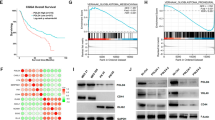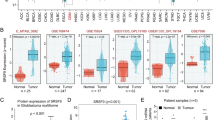Abstract
B cell CLL/lymphoma 11B (Bcl11b), a C2H2 zinc finger transcription factor, not only serves as a critical regulator in development but also plays the controversial role in T cell acute lymphoblastic leukemia (T-ALL). We previously found that the enriched expression of Bcl11b was detected in high tumorigenic C6 glioma cells. However, the role of Bcl11b in glioma malignancy and its mechanisms remains to be uncovered. In this study, using the lentivirus-mediated knockdown (KD) approach, we found that Bcl11b KD in tumorigenic C6 cells reduced the cell proliferation, colony formation, and migratory ability. The results were further verified using two human malignant glioma cell lines, U87 and U251 cells. A cyclin-dependent kinase inhibitor p21, a known Bcl11b target, was significantly upregulated in tumorigenic C6, U87, and U251 cells after Bcl11b KD. Cellular senescence was observed by examination of the β-galactosidase activity in U87 and U251 cells with Bcl11b KD. Reduced expression of stemness gene Sox-2 and its downstream effector Bmi-1 was also observed in U87 and U251 cells with Bcl11b KD. These results suggest that the ablation of Bcl11b gene expression induced glioma cell senescence. Propidium iodide (PI) staining combined with flow cytometry analysis also showed that Bcl11b KD led to the cell cycle arrest of U87 and U251 cells at the G0/G1 or at the S phase, indicating that Bcl11b is required for glioma cell cycle progression. Together, this is the first study to show that the inhibition of Bcl11b suppresses glioma cell growth by regulating the expression of the cell cycle regulator p21 and stemness-associated genes (Sox-2/Bmi-1).







Similar content being viewed by others
Abbreviations
- Bcl11b:
-
B cell CLL/lymphoma 11B
- CKI:
-
Cyclin-dependent kinase inhibitor
- EtOH:
-
Ethanol
- HCl:
-
Hydrogen chloride
- HDAC:
-
Histone deacetylase
- KD:
-
Knockdown
- PI:
-
Propidium iodide
References
Avram D, Fields A, Pretty On Top K, Nevrivy DJ, Ishmael JE, Leid M (2000) Isolation of a novel family of C(2)H(2) zinc finger proteins implicated in transcriptional repression mediated by chicken ovalbumin upstream promoter transcription factor (COUP-TF) orphan nuclear receptors. J Biol Chem 275(14):10315–10322
Wakabayashi Y, Watanabe H, Inoue J, Takeda N, Sakata J, Mishima Y, Hitomi J, Yamamoto T, Utsuyama M, Niwa O, Aizawa S, Kominami R (2003) Bcl11b is required for differentiation and survival of alphabeta T lymphocytes. Nat Immunol 4(6):533–539
Arlotta P, Molyneaux BJ, Chen J, Inoue J, Kominami R, Macklis JD (2005) Neuronal subtype-specific genes that control corticospinal motor neuron development in vivo. Neuron 45(2):207–221
Golonzhka O, Metzger D, Bornert JM, Bay BK, Gross MK, Kioussi C, Leid M (2009) Ctip2/Bcl11b controls ameloblast formation during mammalian odontogenesis. Proc Natl Acad Sci U S A 106(11):4278–4283
Arlotta P, Molyneaux BJ, Jabaudon D, Yoshida Y, Macklis JD (2008) Ctip2 controls the differentiation of medium spiny neurons and the establishment of the cellular architecture of the striatum. J Neurosci 28(3):622–632
Golonzhka O, Liang X, Messaddeq N, Bornert JM, Campbell AL, Metzger D, Chambon P, Ganguli-Indra G, Leid M, Indra AK (2009) Dual role of COUP-TF-interacting protein 2 in epidermal homeostasis and permeability barrier formation. J Investig Dermatol 129(6):1459–1470
Wakabayashi Y, Inoue J, Takahashi Y, Matsuki A, Kosugi-Okano H, Shinbo T, Mishima Y, Niwa O, Kominami R (2003) Homozygous deletions and point mutations of the Rit1/Bcl11b gene in gamma-ray induced mouse thymic lymphomas. Biochem Biophys Res Commun 301(2):598–603
Cismasiu VB, Adamo K, Gecewicz J, Duque J, Lin Q, Avram D (2005) BCL11B functionally associates with the NuRD complex in T lymphocytes to repress targeted promoter. Oncogene 24(45):6753–6764
Cherrier T, Suzanne S, Redel L, Calao M, Marban C, Samah B, Mukerjee R, Schwartz C, Gras G, Sawaya BE, Zeichner SL, Aunis D, Van Lint C, Rohr O (2009) p21(WAF1) gene promoter is epigenetically silenced by CTIP2 and SUV39H1. Oncogene 28(38):3380–3389
Topark-Ngarm A, Golonzhka O, Peterson VJ, Barrett B Jr, Martinez B, Crofoot K, Filtz TM, Leid M (2006) CTIP2 associates with the NuRD complex on the promoter of p57KIP2, a newly identified CTIP2 target gene. J Biol Chem 281(43):32272–32283
Przybylski GK, Dik WA, Wanzeck J, Grabarczyk P, Majunke S, Martin-Subero JI, Siebert R, Dolken G, Ludwig WD, Verhaaf B, van Dongen JJ, Schmidt CA, Langerak AW (2005) Disruption of the BCL11B gene through inv(14)(q11.2q32.31) results in the expression of BCL11B-TRDC fusion transcripts and is associated with the absence of wild-type BCL11B transcripts in T-ALL. Leukemia 19(2):201–208
Gutierrez A, Kentsis A, Sanda T, Holmfeldt L, Chen SC, Zhang J, Protopopov A, Chin L, Dahlberg SE, Neuberg DS, Silverman LB, Winter SS, Hunger SP, Sallan SE, Zha S, Alt FW, Downing JR, Mullighan CG, Look AT (2011) The BCL11B tumor suppressor is mutated across the major molecular subtypes of T-cell acute lymphoblastic leukemia. Blood 118(15):4169–4173
Kamimura K, Ohi H, Kubota T, Okazuka K, Yoshikai Y, Wakabayashi Y, Aoyagi Y, Mishima Y, Kominami R (2007) Haploinsufficiency of Bcl11b for suppression of lymphomagenesis and thymocyte development. Biochem Biophys Res Commun 355(2):538–542
Nagel S, Kaufmann M, Drexler HG, MacLeod RA (2003) The cardiac homeobox gene NKX2-5 is deregulated by juxtaposition with BCL11B in pediatric T-ALL cell lines via a novel t(5;14)(q35.1;q32.2). Cancer Res 63(17):5329–5334
Grabarczyk P, Przybylski GK, Depke M, Volker U, Bahr J, Assmus K, Broker BM, Walther R, Schmidt CA (2007) Inhibition of BCL11B expression leads to apoptosis of malignant but not normal mature T cells. Oncogene 26(26):3797–3810
Huang X, Chen S, Shen Q, Chen S, Yang L, Grabarczyk P, Przybylski GK, Schmidt CA, Li Y (2011) Down regulation of BCL11B expression inhibits proliferation and induces apoptosis in malignant T cells by BCL11B-935-siRNA. Hematology 16(4):236–242
Li W, Jiang Z, Li T, Wei X, Zheng Y, Wu D, Yang L, Chen S, Xu B, Zhong M, Jiang J, Hu Y, Su H, Zhang M, Huang X, Geng S, Weng J, Du X, Liu P, Li Y, Liu H, Yao Y, Li P (2015) Genome-wide analyses identify KLF4 as an important negative regulator in T-cell acute lymphoblastic leukemia through directly inhibiting T-cell associated genes. Mol Cancer 14(1):26
Wiles ET, Lui-Sargent B, Bell R, Lessnick SL (2013) BCL11B is up-regulated by EWS/FLI and contributes to the transformed phenotype in Ewing sarcoma. PLoS One 8(3), e59369
Robins HI, Peterson CG, Mehta MP (2003) Combined modality treatment for central nervous system malignancies. Semin Oncol 30(4 Suppl 9):11–22
Watters JJ, Schartner JM, Badie B (2005) Microglia function in brain tumors. J Neurosci Res 81(3):447–455
Lam-Himlin D, Espey MG, Perry G, Smith MA, Castellani RJ (2006) Malignant glioma progression and nitric oxide. Neurochem Int 49(8):764–768
Shai R, Shi T, Kremen TJ, Horvath S, Liau LM, Cloughesy TF, Mischel PS, Nelson SF (2003) Gene expression profiling identifies molecular subtypes of gliomas. Oncogene 22(31):4918–4923
Fang KM, Yang CS, Lin TC, Chan TC, Tzeng SF (2014) Induced interleukin-33 expression enhances the tumorigenic activity of rat glioma cells. Neuro-Oncology 16(4):552–566
Chai KM, Wang CY, Liaw HJ, Fang KM, Yang CS, Tzeng SF (2014) Downregulation of BRCA1-BRCA2-containing complex subunit 3 sensitizes glioma cells to temozolomide. Oncotarget 5(21):10901–10915
Kim HS, Heo JI, Park SH, Shin JY, Kang HJ, Kim MJ, Kim SC, Kim J, Park JB, Lee JY (2014) Transcriptional activation of p21(WAF(1)/CIP(1)) is mediated by increased DNA binding activity and increased interaction between p53 and Sp1 via phosphorylation during replicative senescence of human embryonic fibroblasts. Mol Biol Rep 41(4):2397–2408
Campisi J (2013) Aging, cellular senescence, and cancer. Annu Rev Physiol 75:685–705
Van Meir EG, Kikuchi T, Tada M, Li H, Diserens AC, Wojcik BE, Huang HJ, Friedmann T, de Tribolet N, Cavenee WK (1994) Analysis of the p53 gene and its expression in human glioblastoma cells. Cancer Res 54(3):649–652
Amini S, Fathi F, Mobalegi J, Sofimajidpour H, Ghadimi T (2014) The expressions of stem cell markers: Oct4, Nanog, Sox2, nucleostemin, Bmi, Zfx, Tcl1, Tbx3, Dppa4, and Esrrb in bladder, colon, and prostate cancer, and certain cancer cell lines. Anat Cell Biol 47(1):1–11
Hemmati HD, Nakano I, Lazareff JA, Masterman-Smith M, Geschwind DH, Bronner-Fraser M, Kornblum HI (2003) Cancerous stem cells can arise from pediatric brain tumors. Proc Natl Acad Sci U S A 100(25):15178–15183
Roninson IB (2003) Tumor cell senescence in cancer treatment. Cancer Res 63(11):2705–2715
Ninomiya Y, Cui X, Yasuda T, Wang B, Yu D, Sekine-Suzuki E, Nenoi M (2014) Arsenite induces premature senescence via p53/p21 pathway as a result of DNA damage in human malignant glioblastoma cells. BMB Rep 47(10):575–580
Zhang JW, Zhang SS, Song JR, Sun K, Zong C, Zhao QD, Liu WT, Li R, Wu MC, Wei LX (2014) Autophagy inhibition switches low-dose camptothecin-induced premature senescence to apoptosis in human colorectal cancer cells. Biochem Pharmacol 90(3):265–275
Raabe EH, Lim KS, Kim JM, Meeker A, Mao XG, Nikkhah G, Maciaczyk J, Kahlert U, Jain D, Bar E, Cohen KJ, Eberhart CG (2011) BRAF activation induces transformation and then senescence in human neural stem cells: a pilocytic astrocytoma model. Clin Cancer Res 17(11):3590–3599
Ye L, Wang C, Yu G, Jiang Y, Sun D, Zhang Z, Yu X, Li X, Wei W, Liu P, Cheng J, Du B, Hu L (2014) Bmi-1 induces radioresistance by suppressing senescence in human U87 glioma cells. Oncol Lett 8(6):2601–2606
Sato A, Okada M, Shibuya K, Watanabe E, Seino S, Suzuki K, Narita Y, Shibui S, Kayama T, Kitanaka C (2013) Resveratrol promotes proteasome-dependent degradation of Nanog via p53 activation and induces differentiation of glioma stem cells. Stem Cell Res 11(1):601–610
Liu ZG, Liu L, Xu LH, Yi W, Tao YL, Tu ZW, Li MZ, Zeng MS, Xia YF (2012) Bmi-1 induces radioresistance in MCF-7 mammary carcinoma cells. Oncol Rep 27(4):1116–1122
Schmitz M, Temme A, Senner V, Ebner R, Schwind S, Stevanovic S, Wehner R, Schackert G, Schackert HK, Fussel M, Bachmann M, Rieber EP, Weigle B (2007) Identification of SOX2 as a novel glioma-associated antigen and potential target for T cell-based immunotherapy. Br J Cancer 96(8):1293–1301
Acknowledgments
The work was supported by the National Science Council, Taiwan (NSC99-2628-B-006-030-MY3, NSC 102-2314-B-006-058, and NSC 102-2811-B-006-017).
Ethical Statement
The study did not involve any human participants and/or animals.
Conflict of Interest
The authors declare that they have no competing interests.
Author information
Authors and Affiliations
Corresponding author
Additional information
Chih-Kai Liao and Kuan-Min Fang contributed equally to this work.
Electronic supplementary material
Below is the link to the electronic supplementary material.
Supplementary Material Fig. S1
Bcl11b knockdown induces cell senescence of U87 and C6 cells. U87 (A) and C6-1 (B) cells infected by lenti-sh-ctrl (mock), lenti-sh-hBcl11b (KD1) and lenti-sh-rno-1682 (KD2) were reseeded in a 96-well plate. Following incubation for 24 h, the cells were lysed and then subjected to 96-well cellular senescence assay kit (Cell Biolabs, Inc.). Absorbance was measured at 360 nm (Excitation)/465 nm (Emission) using an ELISA-plated reader. The quantitative data represent as relative fluorescence units (RFU) of 3 independent experiments.* p < 0.05 versus mock. (DOCX 67 kb)
Supplementary Material Table 1
The measurement of in vivo tumor size in C6 glioma with Bcl11b kncokdown. 1×106 cells of C6-1 cells were infected by lentivirus containing sh-ctrl (mock), by sh-hBcl11b-916 (KD1), or by sh-rnoBcl11b-1682 (KD2). These cells were then implanted into rat cerebral cortex. At 14 dpi, the isolated rat brains were sectioned and then were subjected into H&E staining. UTHSCSA Image tool for Windows was used for the measurement of the tumor size. The tumor size (mm3) in each glioma-bearing brain slice was analyzed by measurement of tumor area (mm2) multiplied by slice thickness (20 μm). The total tumor volume (mm3) in one animal was estimated by summing up the tumor sizes (mm3). (DOCX 14 kb)
Rights and permissions
About this article
Cite this article
Liao, CK., Fang, KM., Chai, K. et al. Depletion of B cell CLL/Lymphoma 11B Gene Expression Represses Glioma Cell Growth. Mol Neurobiol 53, 3528–3539 (2016). https://doi.org/10.1007/s12035-015-9231-1
Received:
Accepted:
Published:
Issue Date:
DOI: https://doi.org/10.1007/s12035-015-9231-1




